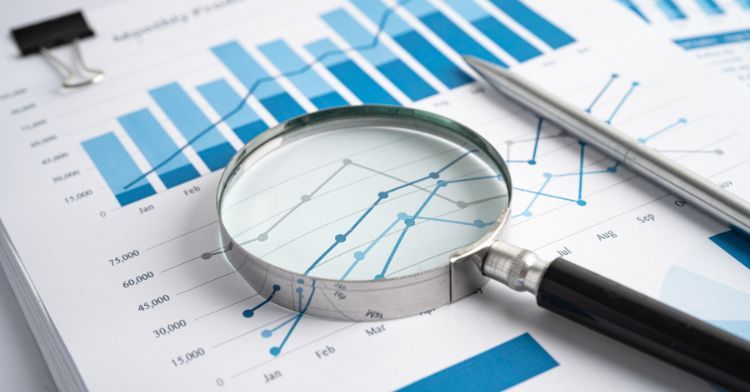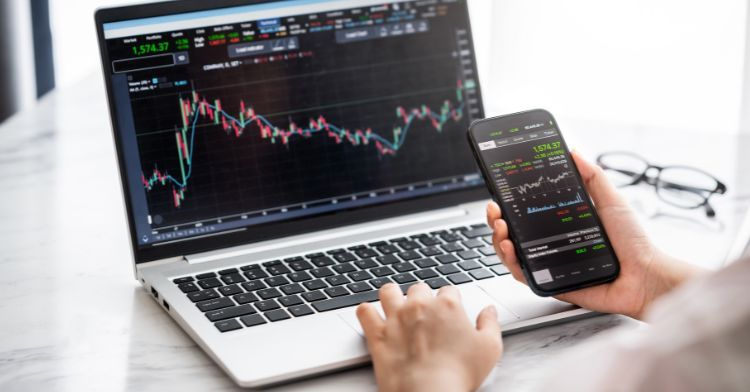Monday Mar 18 2024 01:37

11 min

As a trader, one of the most important tools in your arsenal is the moving average. Moving averages help smooth out price data and provide valuable insights into the overall trend of a security.
There are several types of moving averages, but in this article, we will focus on two popular ones - simple moving averages (SMAs) and exponential moving averages (EMAs).
Understanding the differences between SMAs and EMAs can help you make better trading decisions and choose the right moving average for your specific trading style and needs.
SMAs are the most basic type of moving average and are widely used by traders. They are calculated by taking the average closing price of a security over a specified number of periods.
For example, a 50-day SMA calculates the average closing price of a security over the past 50 trading days. SMAs are easy to calculate and provide a smooth line that follows the overall trend of the security.
The SMA is calculated by adding together the closing prices of an asset for a set number of time periods and then dividing that total by the number of periods. Mathematically, the SMA formula is expressed as:

Where P1, P2, P3,..Pn represents the closing prices over n periods. This arithmetic not only flattens out data series fluctuations but also simplifies the historical price data to a single line, aiding in the detection of trends and patterns within the market's movements.
As new data becomes available, the SMA updates by dropping the oldest price in the period and including the newest price, maintaining a constant period length for the average.
There are several benefits to using SMAs in your trading strategy.

As mentioned above, calculating SMAs is relatively straightforward. Simply add up the closing prices of a security over a specified number of periods and divide it by the number of periods. For example, to calculate a 50-day SMA, add up the closing prices of the security over the past 50 trading days and divide it by 50.
Interpreting SMAs involves understanding the relationship between the price and the SMA. When the price is above the SMA, it indicates an uptrend, while a price below the SMA suggests a downtrend.
Additionally, the angle and slope of the SMA can provide further insights into the strength of the trend. A steeply rising SMA indicates a strong uptrend, while a steeply declining SMA suggests a strong downtrend.
SMAs can be used in a variety of trading strategies. One common strategy is the SMA crossover, where you look for the intersection of two SMAs of different periods.
For example, when a shorter-term SMA, such as the 20-day SMA, crosses above a longer-term SMA, like the 50-day SMA, it is considered a bullish signal.
Conversely, when the shorter-term SMA crosses below the longer-term SMA, it is a bearish signal.
Another strategy is using SMAs as dynamic support and resistance levels. Traders often look for buying opportunities when the price of a security bounces off the SMA and finds support.
Similarly, they may look for selling opportunities when the price approaches the SMA and acts as resistance.
It's worth noting that SMAs are not foolproof and should be used in conjunction with other technical indicators or chart patterns for better accuracy. Additionally, the choice of SMA period will depend on your trading style and the time frame you are trading.
While SMAs provide a simple and effective way to analyse trends, EMAs offer a more responsive and dynamic approach. EMAs give more weight to recent price data, making them more sensitive to price changes compared to SMAs. This can be beneficial for traders who prefer to react quickly to market movements.

The key difference between SMAs and EMAs lies in the calculation method. While SMAs give equal weight to all periods, EMAs assign more weight to recent price data. This means that EMAs react faster to price changes and are more responsive to short-term trends.
Another difference is that EMAs can be more prone to whipsaws, which are false signals caused by sudden price fluctuations. SMAs, on the other hand, tend to be smoother and less susceptible to whipsaws.
The choice between SMAs and EMAs depends on your trading style and needs. If you prefer a more conservative approach and want to focus on long-term trends, SMAs may be more suitable. SMAs provide a smoother line that filters out noise and gives a clearer picture of the overall trend. They are also less likely to generate false signals.
On the other hand, if you are an active trader who wants to react quickly to short-term price movements, EMAs may be a better choice. EMAs are more responsive to price changes and can help you identify short-term trends and potential entry or exit points more effectively.
However, it's important to note that EMAs can be more volatile and may generate more false signals, so proper risk management is crucial.
Choosing the right moving average for your trading needs requires careful consideration of your trading style, time frame, and risk tolerance. If you are a long-term investor or swing trader, a longer-term SMA, such as the 50-day or 200-day SMA, may be more suitable. These SMAs provide a broader view of the trend and are less prone to short-term fluctuations.
For active traders or day traders, shorter-term SMAs or EMAs may be more appropriate. A 20-day or 50-day SMA can help identify short-term trends and potential entry or exit points. EMAs, with their faster response to price changes, can be particularly useful for quick trades or scalping strategies.
Ultimately, the choice between SMAs and EMAs is a personal one and may require some experimentation to find what works best for you. It's also important to adapt your moving average strategy to different market conditions and adjust your parameters as needed.
SMAs and EMAs are valuable tools for traders to analyse trends and make informed trading decisions. SMAs provide a smoother line that filters out noise and helps identify the overall trend of a security.
On the other hand, EMAs are more responsive to short-term price changes and can help active traders react quickly to market movements.
When choosing the right moving average for your trading style and needs, consider factors such as your time frame, risk tolerance, and preferred trading strategy.
Experiment with different SMAs and EMAs to find what works best for you, and remember to adapt your moving average strategy to different market conditions.
By understanding the differences between SMAs and EMAs and using them effectively in your trading, you can gain a valuable edge in the market and improve your trading performance.
Open a live trading account now and start trading CFDs like a pro!
“When considering “CFDs” for trading and price predictions, remember that trading CFDs involves a significant risk and could result in capital loss. Past performance is not indicative of any future results. This information is provided for informative purposes only and should not be considered investment advice.”